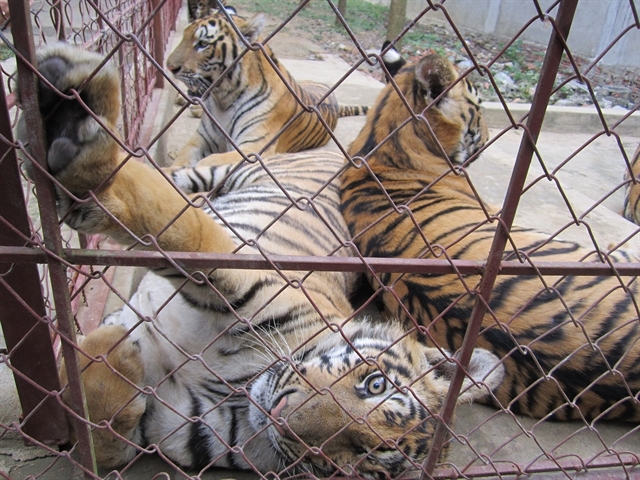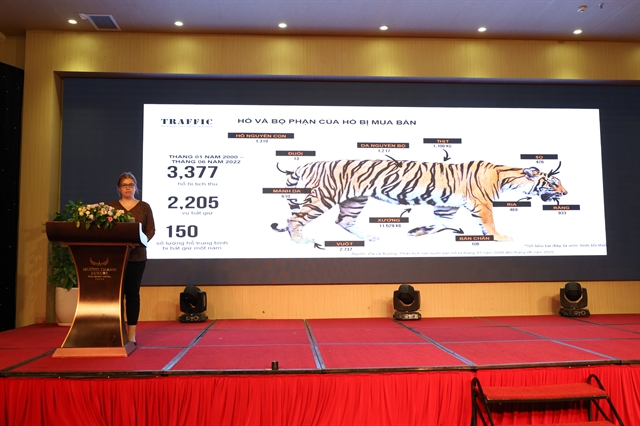 Environment
Environment

 |
| Tigers are found living on a captive farm in Việt Nam. National and international management officers and experts on tiger conservation worked together to discuss solutions to manage captive tigers in Việt Nam. — Photo courtesy of WWF |
PHÚ QUỐC ISLAND — The Forest Protection Department (FPD) recently hosted a Technical Dialogue on the Framework for the Management of Tiger Facilities in Việt Nam, aiming to develop a national system to manage tigers using individual DNA profiles and stripe patterns.
The initiative also seeks to define the terms for breeding and keeping tigers for conservation purposes and to ensure proper care and welfare standards for tigers in captivity.
This dialogue, supported by the US Agency for International Development (USAID) via the Saving Threatened Wildlife project, was executed by the Management Board for Forestry Projects (MBFP) from the Ministry of Agriculture and Rural Development (MARD) in collaboration with WWF.
The event witnessed the involvement of 60 national and international conservation officers and tiger conservation specialists. They convened to address the management of captive tigers in Việt Nam. WWF noted that the Framework is set to undergo revisions and will be presented to MARD for review.
Tigers are globally endangered and are protected both nationally and internationally under the Convention on International Trade in Endangered Species of Wild Fauna and Flora (CITES). CITES requires all member states to implement measures to restrict captive tiger populations to a level supportive only of conserving wild tigers and to prevent breeding for trade in their parts and derivatives.
In Việt Nam, according to FPD, approximately 388 tigers are kept in zoos, safaris and under private ownership. In 2020, the Prime Minister assigned MARD to organise an assessment of the status of the five private facilities allowed to keep/breed tigers for conservation purposes. Based on these assessments, the development of a National Framework for the Management of Captive Tigers has been proposed.
 |
| Heather Sohl, an expert from Tiger Trade Lead, WWF, presents the relationship between captive tigers and the illegal tiger trade as well as international experiences in captive tiger management. — Photo courtesy of WWF |
“Implementing Directive No. 29/CT-TTg (23 July 2020) issued by the Prime Minister on some urgent solutions to address the management of wildlife species, FPD has coordinated with relevant units to conduct a survey and evaluation of the current situation of tiger farming as well as tiger management. We realise that there are remaining difficulties and challenges for tiger facilities as well as management and supervision by the authorities,” said Bùi Chính Nghĩa, director of the Forest Protection Department under the MARD.
“Based on these assessments, the development of a National Framework for the Management of Captive Tigers has been proposed with several new solutions such as: managing and monitoring tigers using DNA technology, striped images, microchips, etc. to serve the purpose of origin traceability; completing relevant legal policies; strengthening the effectiveness of law enforcement, preventing and stopping illegal trade, captivity, and use of tigers' parts and derivatives,” he said.
“The dialogue will contribute ideas to FPD to complete the National Framework for the Management of Captive Tigers, ensuring compliance with the provisions of CITES, Vietnamese law, and the practical situation,” he added.
“Tigers are an endangered, precious, and rare species with a very high risk of extinction due to illegal hunting, trading, raising, and breeding. Therefore, they must be protected under international conventions and national law. Việt Nam has been working to show our commitment to the conservation of tigers, especially in captive facilities. With the contribution of national and international experts, we are looking forward to the completion of the Framework for the Management of Captive Tigers in Việt Nam,” said MBFP Director Đỗ Quang Tùng.
The technical dialogue provided participants with information on the state of captive tigers in Việt Nam and the measures necessary to improve their management and compliance with CITES. Examples and discussion of the current status and practical experience of managing captive tigers in other countries were also highlighted.
“The management of captive tigers requires the collective effort from Government agencies, facility owners, and partners from international organisations. This was well reflected in the diversity of participants from different sectors joining the technical dialogue today. We welcome the opportunity to have expert input for the improved management of captive tigers in Việt Nam,” said Michelle Owen, Chief of Party - Saving Threatened Wildlife project. — VNS




